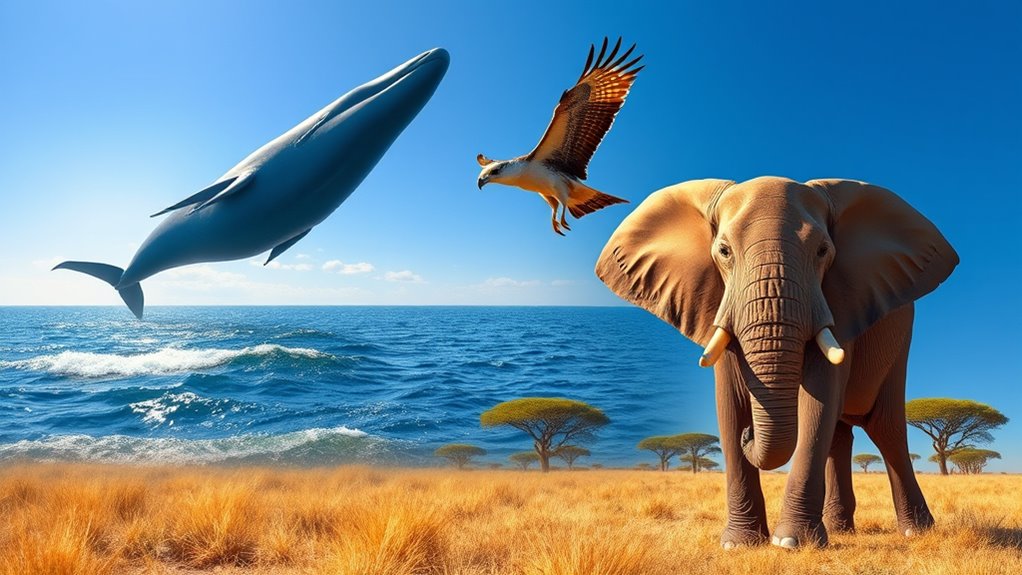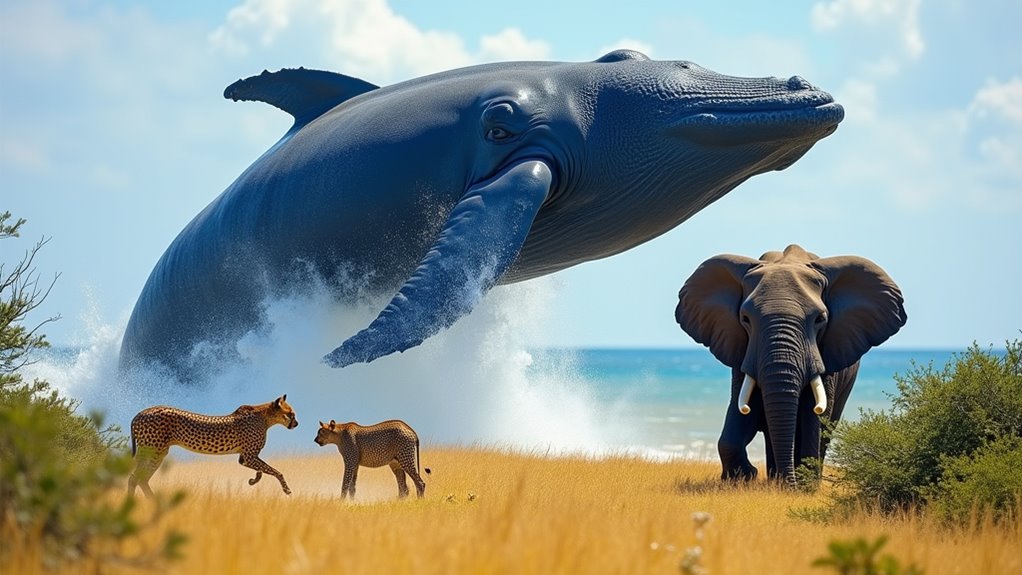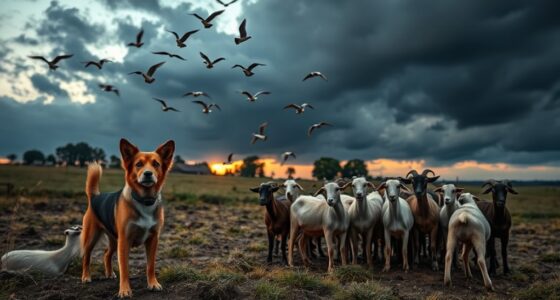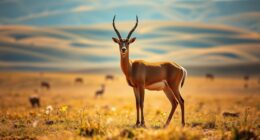If you’re curious about animal record breakers, you’ll find impressive feats like the sailfish, the fastest fish reaching 68 mph, and the peregrine falcon, diving over 240 mph. The largest animal is the blue whale, growing up to 98 feet long and weighing around 200 tons. Strength-wise, elephants can push over trees, and cheetahs can hit 70 mph in short bursts. To discover more amazing survival strategies and adaptations, keep exploring these incredible creatures.
Key Takeaways
- Sailfish holds the speed record among fish, reaching up to 68 mph in the water.
- The blue whale is the largest animal, measuring nearly 98 feet long and weighing around 200 tons.
- The African elephant is the strongest land animal, capable of lifting several times its body weight.
- The peregrine falcon is the fastest bird, diving at speeds over 240 mph during hunting.
- Tardigrades are among the most resilient creatures, surviving extreme conditions like radiation and space vacuum.

Have you ever wondered which animals hold the world records for the fastest, biggest, or most unusual feats? When you look into animal record breakers, you realize just how incredible nature can be. Marine life, in particular, offers some of the most astonishing examples. For instance, the sailfish is known as the fastest fish in the ocean, reaching speeds of up to 68 miles per hour. Its sleek body and pointed bill help it cut through water with ease, making it a true record holder among marine creatures. But marine life isn’t only about speed; it also involves size and rarity. The blue whale, the largest animal on Earth, can grow up to 98 feet long and weigh as much as 200 tons. Its enormous size is a record in the animal kingdom, showcasing how evolution can produce such giants. However, many of these impressive marine species are endangered, threatened by overfishing, pollution, and climate change. Their status reminds you that these record-breaking animals are not only fascinating but also vulnerable, emphasizing the importance of conservation efforts to protect them for future generations. Understanding the adaptations that enable such animals to achieve these feats highlights the incredible diversity and resilience of life in nature. These adaptations often involve specialized features that help animals survive and thrive in their unique environments. Additionally, studying these creatures can reveal how evolutionary processes contribute to their remarkable abilities.
Beyond marine creatures, the animal kingdom hosts record-holders in strength, agility, and endurance. The elephant, for example, is the strongest land animal, capable of lifting weights several times its own body mass. African elephants can push over trees and carry massive loads, showcasing their incredible power. Meanwhile, on the other end of the spectrum, some animals excel in speed or agility. The peregrine falcon is the fastest bird, diving at speeds over 240 miles per hour during its hunting stoop. This incredible speed allows it to catch prey in mid-air, making it a true aerial record holder. Not all record-breaking animals are large or fast; some are small but astonishingly resilient. The tardigrade, often called water bears, can survive extreme conditions that would destroy most life forms. They endure radiation, extreme temperatures, and even the vacuum of space, holding records for resilience that fascinate scientists and nature lovers alike. Their remarkable resilience is a testament to the diverse survival strategies that animals have developed over millions of years. Exploring the biological features that enable these animals to survive in such harsh conditions can deepen your understanding of evolution and adaptation. Interestingly, some animals have developed specialized adaptations to thrive in extreme environments, such as high pressure or absence of light. These unique traits demonstrate the incredible ways in which life can adapt to almost any condition on Earth.
In the animal record books, you’ll also find unusual or bizarre feats. The cheetah holds the record for the fastest land animal, reaching 70 miles per hour in short bursts, but it’s also a symbol of speed and grace. The animal kingdom’s diversity means that records are constantly being challenged and broken, highlighting nature’s endless capacity for adaptation and surprise. Whether it’s the gigantic blue whale or the tiny tardigrade, each record holder tells a story of evolution, survival, and sometimes, the urgent need for conservation. These animals remind you that behind every impressive feat is a story worth protecting, ensuring that these remarkable creatures continue to inspire awe for generations to come.
Frequently Asked Questions
How Are Animal Records Officially Verified and Documented?
When you ask how animal records are verified, you should know that record verification methods involve strict procedures to guarantee accuracy. Experts measure and observe the animal’s performance or size, then compare it against established documentation standards. They often require multiple tests, video evidence, and independent witnesses. This process guarantees that records are legitimate, consistent, and well-documented, providing a reliable way to celebrate these extraordinary animal achievements.
What Factors Contribute to Animals Breaking Record Speeds or Sizes?
You might find it fascinating that animals break record speeds or sizes due to genetic adaptations and habitat influences. For example, a cheetah reaches speeds up to 70 mph thanks to sleek body design and muscle efficiency, shaped by its environment. These factors enable animals to excel in their niches, pushing boundaries through evolution. Your understanding of how genetics and habitat impact animal traits reveals the incredible ways nature promotes record-breaking feats.
Are Record-Breaking Animals Typically Wild or Domesticated?
You might wonder if record-breaking animals are usually wild or domesticated. Typically, wild animals exhibit wild animal adaptations that enable them to achieve extraordinary speeds or sizes, while domesticated traits often limit such extremes. Though some domesticated animals can be record-holders, most record-breaking creatures are wild, showcasing natural adaptations that help them survive and thrive in their environments. Your focus should be on understanding these innate traits.
How Do Environmental Changes Affect Animal Record Achievements?
You see, climate change impacts, habitat destruction, and shifting ecosystems all threaten animal record achievements. As environments change, animals face challenges like reduced food sources, altered migration paths, and increased stress, making it harder to set records for speed, strength, or size. These environmental shifts disrupt natural adaptations, forcing creatures to adapt or falter. In this way, changing conditions directly influence their ability to break records and thrive.
Can Animals Break Multiple Records Simultaneously?
You might wonder if animals can break multiple records at once. It’s possible, especially if an animal exhibits exceptional agility and strength. For example, a cheetah’s speed and agility could set records simultaneously, while its record longevity depends on factors like health and environment. However, breaking multiple records requires a rare combination of traits, so while it’s achievable, it’s more common for animals to excel in one area at a time.
Conclusion
Now that you’ve seen these incredible record-breaking animals, it’s amazing to think how nature constantly surprises us. Did you know the blue whale is the largest creature ever, reaching up to 100 feet long and weighing as much as 200 tons? These giants remind us of the incredible diversity and strength in the animal kingdom. Keep exploring, because there’s always more fascinating facts waiting to be discovered right in the wild!










